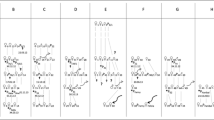Abstract
I report results of a 4-year study, which profiles grooming partners of immature blue monkeys in a Kenyan rain forest. The analysis focuses on the degree to which mothers and offspring were preferred grooming partners and on sex differences in grooming partners. Subjects ranged in age from 0 to 6 years and were members of one study group in which kinship relations were known from long-term study. Immatures often had their mothers as the top-ranked partner. Even more reliably, however, adult females had their offspring as top-ranked immature partners. As offspring grew older, they tended to fall in the rank ordering of their mothers' immature grooming partners, especially when younger siblings were born. Immature males had fewer grooming partners overall than female peers did. Thus, immature females diversified their partners more than males did, especially by establishing grooming relations with immature female partners. Immatures of both sexes had more female partners than expected by chance. Observed sex differences suggest that immature female blue monkeys may use grooming to cultivate relationships with long-term future benefits. It is less clear that the grooming of immature males functions in this way. Immatures of both sexes may also use grooming to maintain relationships of current value, to practice for future social exchange, and to keep clean, and some of their grooming may be in the primary interest of their partners, rather than themselves. In general, immature blue monkeys resemble the immatures of other catarrhine taxa in the way in which grooming is distributed among various partners.
Similar content being viewed by others
REFERENCES
Cheney, D. L. (1978). Interactions of immature male and female baboons with adult females. Anim. Behav. 26: 389-408.
Cords, M. (1987). Mixed-species association of Cercopithecus monkeys in the Kakamega Forest, Kenya. University of California Publications in Zoology, Vol. 117.
Cords, M. (1997). Friendships, alliances, reciprocity and repair. In Whiten, A. and Byrne, R. W. (eds.), Machiavellian Intelligence II: Extensions and Evaluations, Cambridge University Press, Cambridge, pp. 24-49.
Cords, M. (2000). The number of males in guenon groups. In Kappeler, P. (ed.), Primate Males, Cambridge University Press, Cambridge, pp. 84-96.
Fairbanks, L. A. (1993). Juvenile vervet monkeys: Establishing relationships and practicing skills for the future. In Pereira, M. E. and Fairbanks, L. A. (eds.), Juvenile Primates: Life History, Development and Behavior, Oxford University Press, New York, pp. 211-227.
Fairbanks, L. A., and McGuire, M. T. (1985). Relationships of vervet mothers with sons and daughters from one through three years of age. Anim. Behav. 33: 40-50.
Glick, B. B., Eaton, G. G., Johnson, D. F., and Worlein, J. M. (1986). Development of partner preferences in Japanese macaques (Macaca fuscata): Effects of gender and kinship during the second year of life. Int. J. Primatol. 7: 467-479.
Horrocks, J. A., and Hunte, W. (1993). Interactions between juveniles and adult males in vervets: Implications for adult male turnover. In Pereira, M. E. and Fairbanks, L. A. (eds.), Juvenile Primates: Life History, Development and Behavior, Oxford University Press, New York, pp. 228-239.
Kurland, J. A. (1977). Kin Selection in the Japanese Monkey (Contributions to Primatology). Karger, Basel.
Kummer, H. (1978). On the value of social relationships to nonhuman primates: A heuristic scheme. Soc. Sci. Inf. 17: 687-705.
Lee, P. C. (1983). Play as a means for developing relationships. In Hinde, R. A. (ed.), Primate Social Relationships, Sinauer Associates, Sunderland, MA, pp. 82-89.
Missakian, E. A. (1974). Mother-offspring grooming relations in rhesus monkeys. Arch. Sex. Behav. 3: 135-141.
Nakamichi, M. (1989). Sex differences in social development during the first 4 years in a free-ranging group of Japanese monkeys, Macaca fuscata. Anim. Behav. 38: 737-748.
Nash, L. T. 1993. Juveniles in nongregarious primates. In Pereira, M. E., and Fairbanks, L. A. (eds.), Juvenile Primates: Life History, Development and Behavior, Oxford University Press, New York, pp. 119-137.
O'Brien, T. G. (1993). Asymmetries in grooming interactions between juveniles and adult female wedge-capped capuchin monkeys. Anim. Behav. 46: 929-938.
O'Brien, T. G., and Robinson, J. G. (1993). Stability of social relationships in female wedge-capped capuchin monkeys. In Pereira, M. E. and Fairbanks, L.A. (eds.), Juvenile Primates: Life History, Development and Behavior, Oxford University Press, New York, pp. 197-210.
Pereira, M. E., and Altmann, J. (1985). Development of social behavior in free-living nonhuman primates. In Watts, E. S. (ed.), Nonhuman primate models for human growth and development, Alan R. Liss, New York, pp. 217-309.
Pereira, M. E., and Fairbanks, L. A., (eds.) (1993). Juvenile Primates: Life History, Development and Behavior, Oxford University Press, New York.
Rowell, T. E., and Chism, J. B. 1986. The ontogeny of sex differences in the behavior of patas monkeys. Int. J. Primatol. 7: 83-107.
Walters, J. R. (1981). Inferring kinship from behaviour: Maternity determinations in yellow baboons. Anim. Behav. 29: 126-136.
Walters, J. R. (1987). Transition to adulthood. In Smuts, B. B., Cheney, D. L., Seyfarth, R. M., Wrangham, R. W. and Struhsaker, T. T. (eds.), Primate Societies, University of Chicago Press, Chicago, pp. 358-369.
Watts, D. P., and Pusey, A. E. (1993). Behavior of juvenile and adolescent great apes. In Pereira, M. E. and Fairbanks, L. A. (eds.), Juvenile Primates: Life History, Development and Behavior, Oxford University Press, New York, pp. 148-167.
Wolfheim, J. (1977). Sex differences in behavior in a group of captive juvenile talapoin monkeys (Miopithecus talapoin). Behaviour 63: 110-128.
Rights and permissions
About this article
Cite this article
Cords, M. Grooming Partners of Immature Blue Monkeys (Cercopithecus mitis) in the Kakamega. International Journal of Primatology 21, 239–254 (2000). https://doi.org/10.1023/A:1005473403820
Issue Date:
DOI: https://doi.org/10.1023/A:1005473403820




